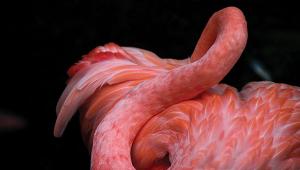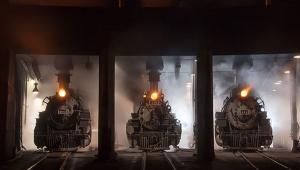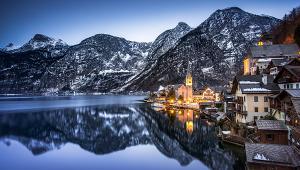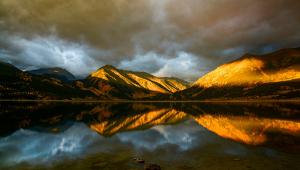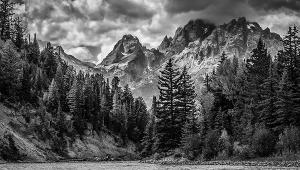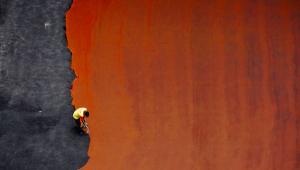Negative Space

When the sun’s coming up or going down you get the best results when you emphasize the brilliant colors in the sky. Composition plays a key role in placing the landforms for the best effect, as was one here in this photo in Banff National Park by Chris Murray. Exposure with a Minolta Maxxum 9 on Fujichrome Velvia film was f/11 at 1/4 sec.
© Chris Murray

This handsome church in downtown Santa Fe holds mystery and myth within its walls, and Michael Gottlieb’s choice of using the full moon and silhouette of the church captures it in a unique way. He used a Nikon D200 and a Nikkor 18-200mm lens at ISO 1250 and an exposure of f/8 at 1/250 sec; his HDR exposure included a -3 EV bracket.
© Michael Gottlieb

Robert K. Bailey made this photo of his wife’s painting space with a Canon EOS 7D and a Canon EF 18-200mm lens and an exposure of f/5.6 at 1/100 sec at ISO 400. His exposure and use of lighting brings the eye right to the painting and to the tools that helped her create it.
© Robert K. Bailey

The play of shadows, including the figures viewing the scene with us, and the shades and tones of the structure create an abstract view of this space. Christine Doyle made this image with a Canon EOS Rebel XSi and an 18-55mm lens and an exposure of f/5.6 at 1/400 sec at ISO 200.
© Christine Doyle

Paul Jolicoeur created this classic negative space image that both reveals key details and obscures forms to bring the viewer’s eye right into the key aspects of the scene. Exposure with a Canon EOS 7D and a Canon EF 70-200mm lens was f/4 at 1/1000 sec at ISO 500.
© Paul Jolicoeur

Steve Lautermilch photographed this architectural detail in Norfolk, Virginia, in a way that makes forms recede and advance, depending on the way your eye focuses on the details of the scene. Exposure with a Nikon D200 and a Micro-Nikkor 105mm f/2.8 lens was aided by use of a polarizing filter.
© Steve Lautermilch

Allen J. Heiss gave himself an assignment to make still life images with a single light and referenced old masters’ work in a series he sent us. He used large color cardboards and a 200-/400-watt tungsten lamp in a reflector. He created this classic look with a Canon EOS Digital Rebel XTi and a Canon EF 70-300mm lens. His exposure was f/8 at 1/125 sec.
© Allen J. Heiss

There’s nothing like high contrast and deep shadows to bring out all the textural qualities in a subject. F.K. Sandercock made this photo at the Drayton Harbor Marina in Blaine, Washington, with a Nikon D3 and a Nikkor 24-120mm f/4 VR lens and an exposure of f/9 at 1/320 sec at ISO 400.
© F.K. Sandercock

Photographed at the de Young Museum in San Francisco, this abstract view relies on texture and deep shadow for its graphic impact. Arnold Benetti worked with a Canon EOS 7D and a Canon EF-S 17-55mm lens and an exposure of f/22 at 1/360 sec at ISO 400.
© Arnold Benetti

Highlight exposure is key to this image made by Tim O’Shaughnessy; deep shadows add drama and impact to the setup. O’Shaughnessy worked with a Nikon D90 and an 18-105mm lens and an exposure of f/16 at 1/250 sec.
© Tim O’Shaughnessy

This mysterious image of an inflatable Statue of Liberty in Gas Works Park, Seattle, being viewed by a group of anonymous and silhouetted figures was made by Mark Sharley. Exposure with a Nikon D300 and a 70-200mm f/2.8 lens was f/3.5 at 1/160 sec at ISO 1250.
© Mark Sharley

This photo by Jim Mitchell is all about the play of shadow and brilliant and brightly colored light and how he chose to expose the frame. Exposure with a Nikon D300 and a Nikkor 28-70mm lens was f/16 at 1/25 sec at ISO 400.
© Jim Mitchell

There’s nothing like a bright white subject sitting against a dark background to create a dynamic scene. Ravi Hirekatur made this photo with a Canon EOS 7D and a Sigma 50-500mm lens and an exacting exposure of f/6.3 at 1/1250 sec at ISO 400.
© Ravi Hirekatur

Using a chalk drawing on a sidewalk as a brilliant backdrop, L. Pete Genzlinger used a shadow form to offset the color and enhance the play of light and color in the frame. Exposure with a Fujifilm JZ was f/2.9 at 1/1000 sec.
© L. Pete Genzlinger

Lighting son Graham with a 1K tungsten Fresnel through a diffusion screen and using a black backdrop, Blair Holmes made this evocative portrait with a Canon EOS 5D and an 80mm lens. Exposure, read from the bright side of Graham’s face, was f/4 at 1/60 sec.
© Blair Holmes
Picture This! – Our Next Assignment
Construction Compositions
Construction sites are filled with colorful and odd objects in juxtaposition, creating numerous photo ops for color and design studies. Our next Picture This! assignment is Construction Compositions, and we’re looking for photos that depict interesting objects within a compositional frame.

© George Schaub
Please Read This
It is important that you read and follow these guidelines. We need to follow
this procedure because of the large volume of images we receive. If you have
any questions, please e-mail us at: editorial@shutterbug.com.
1) Images sent to us cannot be returned. You retain complete copyright over the images, but do grant us permission to print your image(s) in the magazine and on our website, www.shutterbug.com.
2) Because images are not returned please send a quality print or duplicate transparency. We will not accept or view images on CD, ZIP, or any other electronic media.
3) Images will be selected on the basis of content and technical quality. Please mark your outer envelope with the topic of the month (for example, “Wide View”).
4) Enclose a short caption with the image stating camera, lens, film and exposure, plus location. If you are submitting an image with a recognizable person we must have a model release or signed permission from that person to reproduce their image in the magazine and on the website.
5) Please submit no more than three photos for consideration (4x6 up to 81/2x11).
Send your image and information to:
Picture This! Shutterbug Magazine,
1415 Chaffee Dr., Suite #10, Titusville, FL 32780.
Deadline For Submission: April 15, 2013
Images will appear in our July 2013 issue
Our Next Topic: Shallow Depth Of Field
Deadline For Submission:May 15, 2013.
Images will appear in our August 2013 issue
Please note: We receive hundreds of submissions for Picture This! each month and want to be sure we properly identify each image we publish. Please put your name and all camera, exposure information on the back of the print or attached to slides when submitting. Also, please include your e-mail address in case we need to contact you.
Want to see images selected for past Picture This! assignments? Go to www.shutterbug.com and click on Picture This! in the “More Articles…” box on the homepage.
Please note: If you submit images with an enhancement through software beyond contrast, exposure, and simple saturation adjustments please indicate the software and “filter” used to attain that effect.—Editor
- Log in or register to post comments


Photography allows people to capture memorable scenes in our lives by creating meaningful pieces of art. - Reputation Advocate
